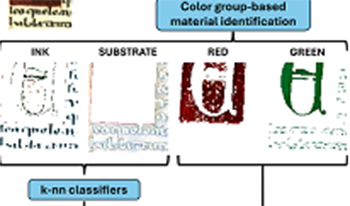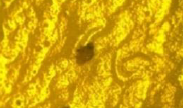
Hyperspectral imaging has been widely and consistently applied in the field of Cultural Heritage for material identification. In the specific context of historical document analysis, it is frequently supported and complemented by additional analytical techniques. In this study, we propose a straightforward method for material identification that combines adaptive direct identification—using a reference library of visible and near-infrared spectral reflectance data for pigments—with a KNN classifier applied to an extended spectral range for inks and supports. The method has demonstrated a high degree of accuracy, successfully identifying materials present in both actual historical documents and mock-ups created following medieval techniques. Its performance is illustrated through three spectral image fragments extracted from the HYPERDOC project database.

Decreasing the use of pesticides is one of the main goals of current agriculture, which requires fast, precise and continuous assessments of crop pests. Citrus pests cause a lot of damage worldwide and the techniques to evaluate them are mainly based on manual, time-consuming readings of insects stuck on traps spread over the crops. This is the case of red scale insects, whose control is notably challenging due to their small size and high reproduction rate. Hence, in this work, we carry out a spectral characterization of this insect in the visible range through spectrometric devices, microscopy and hyperspectral imaging technology to analyze the feasibility of using this information as a means of automatically identifying specimens belonging to this species in this era of precision agriculture. The results obtained show that spectral reflectance differences between red scales and other insects can be recorded at long (red) wavelengths and that red scales are morphologically different, i.e., smaller and more rounded. A reflectance ratio computed from spectral images taken at 774 nm and 410 nm is proposed as a new approach for automated discrimination of red scales from other insects.